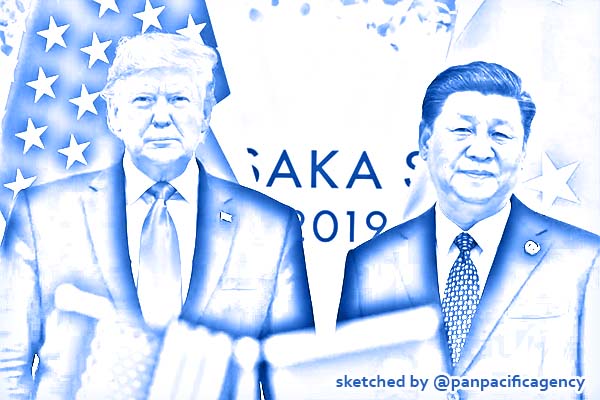Trump talks trade peace, but there’s no deal in sight

President Donald Trump, left, poses for a photo with Chinese President Xi Jinping during a meeting on the sidelines of the G-20 summit in Osaka, Japan on June 29, 2019. Susan Walsh—AP. Sketched by the Pan Pacific Agency.
BIARRITZ, Aug 27, 2019, Asia Times. Athoughtful, calm and encouraging President Trump spoke to the press in Biarritz, France on Aug. 26, in sharp contrast to the emotional, enraged and threatening US leader who tweeted perdition against Beijing late last week. Chinese President Xi Jinping today was a “great leader,” not an “enemy” as Trump called him last week. Asked about the Chinese Vice-Premier’s statement overnight that China was “willing to resolve the issue through consultations and cooperation in a calm attitude,” Trump assured a Chinese journalist that the US was willing to do the same, reported the Asia Times.
Despite Trump’s claim that the US and China were close to a deal, however, Washington and Beijing have radically different ideas about what such a deal might look like.
The US president had the benefit of two days’ of consultation at the Group of Seven summit with at least one foreign leader whom he likes and respects, the United Kingdom’s new Prime Minister Boris Johnson. According to British press reports, Johnson urgently advised Trump to de-escalate the trade war with China, and the US president evidently listened.
Trump nonetheless restated a position that China finds entirely unacceptable, namely that any deal “has to be better for us than it is for them” because of his perception that China has taken advantage of the United States for many years. In the past, Trump’s negotiators have insisted that some US tariffs must remain in place even after a deal is concluded, and that the US must have the unilateral right to impose new tariffs if a bilateral consultation mechanism fails to resolve future issues to mutual satisfaction.
There was no mention, moreover, of the tech war dimension of the conflict. The United States attempted to derail China’s national champion in telecommunications, Huawei Technologies, as it rolled out 5th Generation mobile broadband, first by threatening its allies with a shutdown of intelligence cooperation and then by blocking the sale of components to Huawei by US suppliers.
To Washington’s embarrassment, all of America’s allies except for Japan and New Zealand ignored the threats, and Huawei was able to proceed with the 5G rollout without US components. Even worse for Washington, Huawei released its own chipsets to the market, threatening the world position of such American tech giants as Qualcomm and Nvidia.
As I reported yesterday on this site, China has already won the first and most important engagement in the economic war with the United States, by launching a game-changing Chinese technology on the world market for the first time since the invention of gunpowder. That is an historic win for China, and Washington has sent confused signals about its prospective response.
China signaled Aug. 7 that it had lost patience with the twists and turns of Trump’s negotiating stance, and would pursue its own economic interests regardless of Washington’s sensibilities. It did so by allowing the RMB to depreciate below 7 to the US dollar, an especially sore point with the Trump Administration, which proceeded to label China a “currency manipulator” – a severe form of diplomatic escalation. And when President Trump announced a 10% tariffs on Chinese goods not covered by the previous round of tariffs, China last week announced tariffs on $75 billion of US imports, provoking the Friday Twitter-storm and a nearly 3% drop in US stock prices.
Either because the sharp drop in the stock market frightened him, or because foreign leaders or his own aides warned him of dire consequences, the US president changed his tone today. US equity markets had recovered a bit of their Friday losses as of 12:00 p.m. But the US and China are no closer to a deal now then they were on Friday afternoon, and the US president cannot so easily unring the bell that he rang last week.